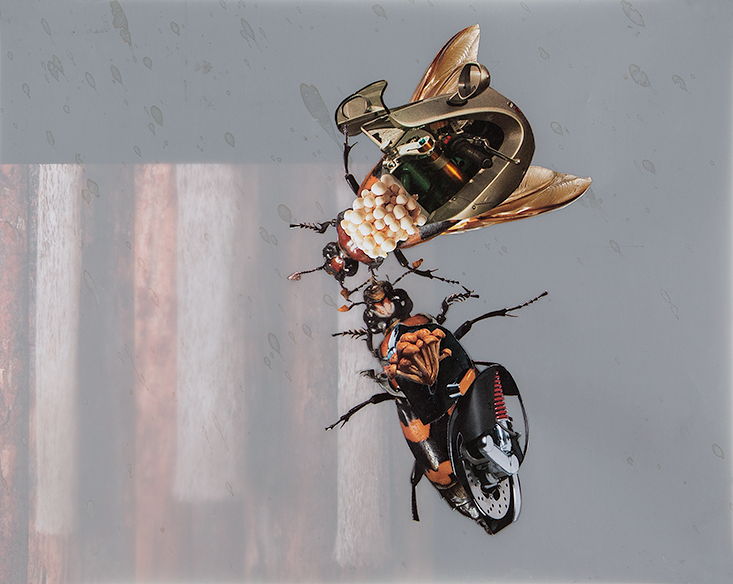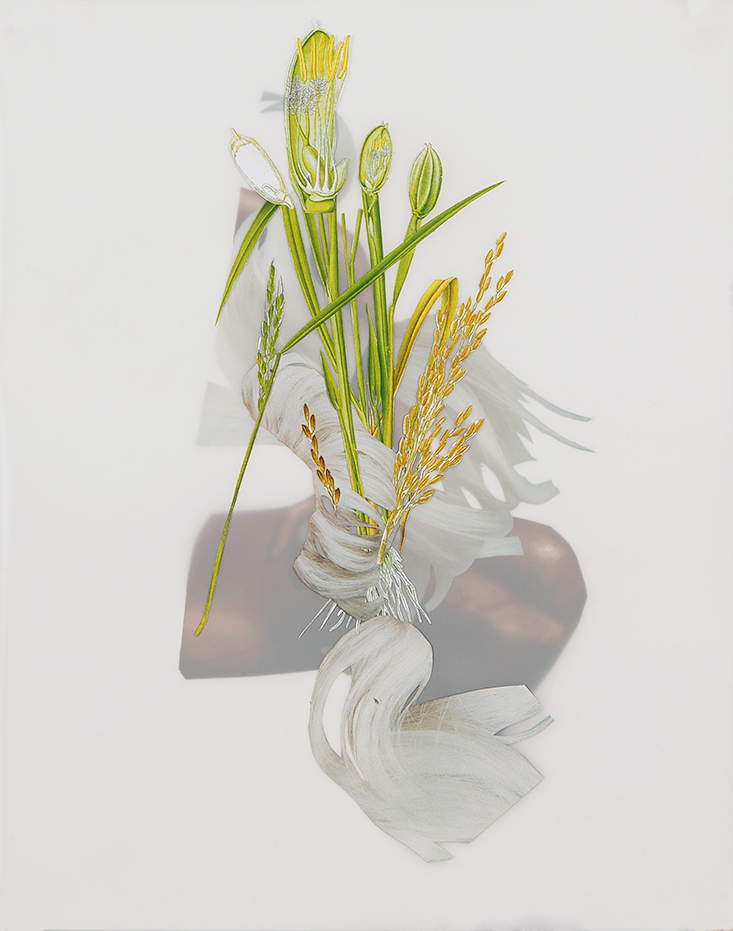Hey Disney, enough with the warm and fuzzy personification of nature! Dress her in a suit and toss her a calculator because deals are going down in the jungle. Sure, some are symbioses, with two creatures partnering for mutual benefit. But others resemble hostile takeovers, as one beast stealthily annexes another. Nautilus asked biologists about their favorite organismal mergers and acquisitions. Here are their top five picks.

Fishy Codependency
At first, the life of the male anglerfish is ordinary. He begins as a wee fish swimming in the ocean. But soon he will face a most serious challenge: finding a mate. Many species of anglerfish live in lightless depths of a mile or more, where females are scarce.
To find her, he undergoes a metamorphosis, in which he becomes a female-seeking projectile. His body narrows and his tail muscles deepen for fast swimming. His nostrils enlarge, becoming larger in relation to his head size than in any other vertebrate, allowing him to detect the faint scent of a distant mate. Finally, his vision becomes telescopic, so that he can hone in on the fleshy, bioluminescent bulb that hangs above a female anglerfish’s head.
When he sees her, there’s no courtship, no wooing, but rather a straight-on assault in which the male attaches himself to the female for life. (He’s always smaller than she is—in some species the males are freckle-sized in comparison to females.) So begins one of the animal kingdom’s great mergers. Their skin fuses; soon their vascular systems do, too. The male’s nostrils and eyes degenerate. His fins fall off. His heart still pumps, but for all intents and purposes he’s become a sperm-generating appendage.
It seems drastic to irrecoverably toss away freedom in return for sex, but the male anglerfish has little alternative in the vast, empty darkness of the deep sea. If he is lucky enough to find love, there’s no reason to ever, ever let go.

Creepy Crawly Conglomerate
Though some beetles have an appetite for bark, it doesn’t always make for an easy meal: To discourage predation, plants suffuse their outer layers with toxins. Rather than eat bark, then, ambrosia beetles evolved to eat fungi that flourish on bark.
Since the dietary crossover occurred 60 million years ago, it’s become fundamental to some 3,000 ambrosia beetle species, as well as the hundreds of fungal species they farm. The beetles cart the fungi around in specialized compartments in their exoskeletons called mycangia. Meanwhile, the fungi inside shut off any of their digestive enzymes that might eat away at the beetles’ shells.
These fungi have become so specialized that they’re often found nowhere in nature except with their beetles. They grow on the walls of burrows where beetle eggs are laid. There, the fungi metabolize and detoxify surrounding plant matter, and nourish beetle larvae. The relationship doesn’t only benefit beetles, of course. In this age of globetrotting transport, when several ambrosia beetles have become invasive, forest-threatening pests, the fungi get plenty of new opportunities to thrive in exotic locales while providing their mules with meals on the go.

DNA Hoarder
Among animals, sexual reproduction—and all the genetic mixing-and-matching opportunities it provides—is nearly universal. A few species can clone themselves asexually, but they still reproduce sexually now and again to flush diversity into the population. However, bdelloid rotifers, tiny, aquatic invertebrates, haven’t had sex for 40 million years. They are entirely female, and they aren’t just going through a dry spell.
How have they made it work? A hint may come from the bdelloid rotifer genome, of which roughly 8 percent can be traced to bacteria, fungi, and plants. The rotifers likely acquire genes from their rotifer neighbors and other animals as well, only those transplants are harder for scientists to detect because they blend in with “native” genes. The foreign genetic sequences are not all inherited from an early rotifer ancestor. Instead they seem to have drifted in over time, perhaps entering—appropriately enough—during literal dry spells, when water-dwelling rotifers become desiccated and the usual cellular barriers to free-floating environmental DNA break down.
When rains come again, rehydrated bdelloid rotifers continue their cycles of life, reproducing asexually while enjoying the sort of genome-updating benefits that sex normally provides. Some of the alien genetic material may prove useful to their offspring, or lay a foundation for future adaptations. And some of it, perhaps even most of it, won’t do much of anything at all, but that’s fine. In that regard, rotifers resemble tech companies that acquire patents almost indiscriminately, banking on the likelihood that a few will eventually pay off.

Moldy Monopolies
From a mycologist’s perspective, ours is a world of fungi. By some estimates, every species of plant has at least 10 fungal species associated with it—growing in and around roots, on stems and leaves, and inside plant bodies. Over evolutionary time, they’ve learned to control their hosts’ behaviors to their advantage, often by producing hormones that plants use to guide their own development.
One such example is Fusarium fujikuroi, the fungal cause of Bakanae disease, a common affliction of rice. Like an unscrupulous company that uses hackers to infiltrate an organization’s computer system, F. fujikuroi secretes gibberellic acid, a plant hormone that induces rapid tissue growth. Gibberellic acid is usually found in root tips, but F. fujikuroi causes it to accumulate in flowering tissue. As a result, infected seedlings grow fast but weak, arching above surrounding plants before toppling to one side. If the fungus is lucky, its hijacked host will fall down and drop fungal spores onto the soil where they’ll settle for the winter before infecting germinating seedlings in the spring. Or, the spores may spread to seeds in the ground, where they can begin the vicious cycle anew.

Sea Slug Snag
Four hundred and fifty million years ago, the ancestors of sea slugs had snail shells. Over evolutionary time, their shells were shed: Though shells appear for a brief moment during their larval stages, adult sea slugs are denuded—but not at all defenseless. Indeed, losing their shells and exposing their bodies led to a series of profitable acquisitions.
For defense against predators, many sea slugs, or nudibranches, pack a punch by making use of what they eat. Free-floating Glaucus atlanticus, a lacy blue and white slug known as a sea swallow or sea dragon, can engulf in a gulp small Portugese Man O’ War jellyfish. But instead of cringing in pain, sea swallows transfer the Man O’ War’s stinging cells from their guts to the fringes of their bodies. It’s not clear how this happens, but whatever the mechanism, sea swallows then cause their predators anguish. Other sea slugs, such as Aplysia gigantea from the Indian and West Pacific oceans, perform this poisonous trick with toxins absorbed from algae they consume.
Algae aren’t only useful for defense, though. Many carnivorous sea slugs make use of zooxanthellae, a type of photosynthetic algae that lives in the open ocean or inside corals and sea anemones, invertebrates that grow on the sea floor. When these creatures are eaten by sea slugs, the single-celled algae inside them make a seamless transition to their new hosts. They’re transferred to sun-exposed tissues where they generate sugars for the sea slug through photosynthesis.
Meanwhile, herbivorous sea slugs embed chloroplasts from algae just below their skin. Some of these slugs have evolved to look like leaves themselves, with wide, flat bodies directed towards ambient rays of light.
Tim Requarth is a neurobiologist at Columbia University in New York.
Jason Stajich is a mycologist at the University of California, Riverside.
Andreas Hejnol is an evolutionary biologist at Sars International Centre for Marine Molecular Biology in Norway.
Eric Edsinger is an evolutionary biologist at Okinawa Institute of Science and Technology in Japan.






























